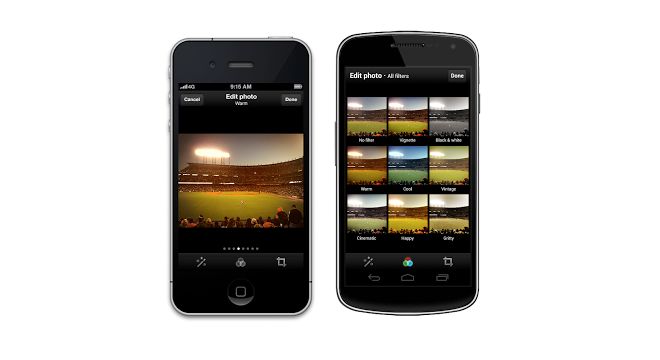Twitter and Instagram used to play well together. In many ways, they seemed the perfect match: Twitter was founded in 2006 as a way to share short messages, and Instagram, after several pivots, became in 2010 the go-to place to post edited photos with multicolored, faux vintage filters. Sharing Instagram photos on Twitter was easy, almost reflexive.
But the two companies rapidly grew apart after Facebook acquired Instagram‘s small team, who began working out of Facebook’s headquarters in September. On Monday, though, the relationship between Instagram and Twitter appeared to have reached a whole new level of competitiveness.
That’s because Twitter, per earlier reports, finally unveiled its own multicolored, faux-vintage photo filters, allowing its users the new capability of editing photos they post on Twitter directly through their smartphones. The new feature is available only as an update to the Twitter apps for iPhone and Android, for now.
Twitter on Monday posted the following video ad showing off the new features:
Meanwhile, hours before Twitter’s unveiling of the photo feature on Monday night, Instagram itself released a massive update, 3.2, for iOS devices, bringing with it a new camera view and icon, a new filter of its own, “Willow,” and expanded integration with Foursquare, a separate geolocation-focused social network based out of New York.
By contrast, Twitter partnered with another New York-based company, Aviary, to provide its new photo filter and editing capabilities.
“Each filter was designed from the ground up exclusively for Twitter, and we couldn’t be more excited about how they turned out,” wrote the company in a blog post on the news.
Twitter, for its part, noted that the eight different photo filters Aviary had built offered users at least one major differentiator over Instagram: The ability to see how a photo would look in each filter simultaneously, using a grid-like view, which Twitter called a “bird’s eye view.”
Twitter’s move also came just days after Instagram completed its phase-out of support for sharing Instagram photos on Twitter, replacing all Instagram photos posted by users to Twitter with links back to the main Instagram website.
The movement undercut one of Twitter’s core new features: Twitter Cards, which can be used to share expanded information in tweets, including multimedia content such as images and video, without leaving the Twitter website or app.
A week prior, when Instagram’s phase-out of Twitter Cards support began, Instagram CEO Kevin Systrom defended that abrupt decision as one that would benefit users by providing them the “best experience,” which he said was to be found on the Instagram.com website.
Systrom also said at the time that Instagram and Twitter would always work together in some capacity, and that both were committed to offering users the best experiences for both their respective products.
Both companies, well — in the case of Instagram, its parent company Facebook — are seeking how to take their huge user bases (Over 100 million in the case of Instagram, and upwards of 140 million in the case of Twitter) and monetize them on mobile devices. Twitter has had early, limited but growing success with this by selling mobile advertisements , but Instagram hasn’t tried putting any advertisements in front of its users — yet.
Throughout 2012, Twitter has tried to reposition itself as less a tech company and more a media company, and the decision to offer photo filters for users alongside other content, such as text and videos, is another way of pursuing that goal. But it’s also likely to crowd and clutter Twitter and detract from its original, primary and singular purpose as a short messaging service.
Instagram itself found much success by being singularly focused on sharing user images, and though it has recently expanded to the Web, it hasn’t yet dipped into other forms of content to quite the extent that Twitter has, perhaps affording it an advantage to users who want a singular experience.
Tension probably escalated between the two companies with a report in late September by the analytics firm comScore that Instagram had surpassed Twitter in terms of average daily active users on mobile devices, 7.3 million to 6.9 million.
So the launches of new, competing products on Monday prove that Instagram and Twitter’s monile photo filter fight is about to get worse before it gets any better.









